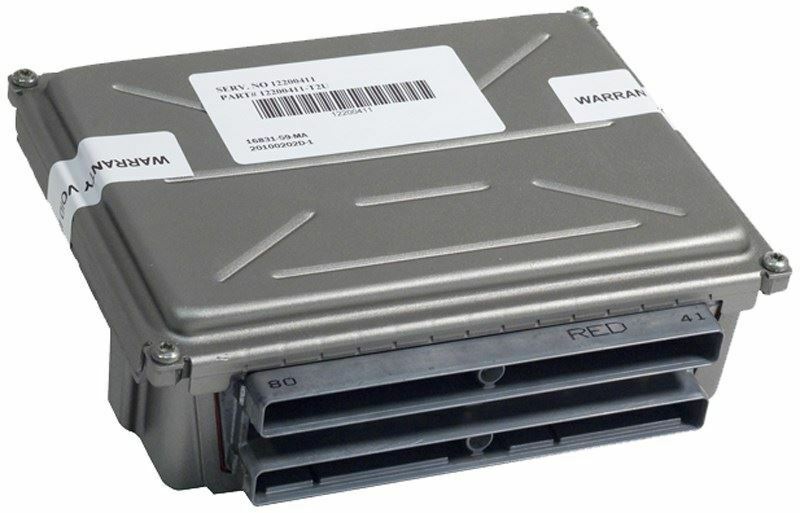Is Your Truck Experiencing Mysterious Engine Problems?
If you’re dealing with a rough-running 1997-2000 Chevrolet S10, GMC Sonoma, or another compatible GM vehicle, the root cause might be the very brain of your engine: the Powertrain Control Module (PCM). A failing PCM can lead to a frustrating array of issues, from poor performance and abysmal fuel economy to a vehicle that won’t start at all. This replacement PCM, part number 16245305, is the definitive solution to restore your vehicle’s reliability and performance.
The PCM is the central command center for your engine and transmission. It processes data from dozens of sensors to precisely control fuel injection, ignition timing, transmission shifting, and emissions systems. When internal components degrade over time due to heat, vibration, or electrical faults, the entire operation of your vehicle can be compromised. Symptoms often start subtly but can quickly escalate, leaving you stranded.
Diagnosing a Faulty 1997-2000 S10 PCM
Identifying a failing engine computer can be tricky, as its symptoms often mimic other failing parts like sensors or fuel system components. If you’ve replaced multiple parts without success, it’s time to consider the PCM. Common indicators of a faulty module include:
- Check Engine Light: A persistent Check Engine Light, especially with communication error codes (U-codes) or codes for multiple, unrelated sensors, is a classic sign.
- No-Start or Intermittent Stalling: The engine may crank but refuse to start, or it might stall unexpectedly while driving and then restart after cooling down.
- Poor Engine Performance: You may notice a significant loss of power, hesitation during acceleration, rough idling, or engine misfires that don’t trace back to spark plugs or coils.
- Reduced Fuel Economy: If the PCM isn’t managing the air-fuel mixture correctly, your gas mileage can plummet without any change in your driving habits.
- Erratic Transmission Behavior: On automatic models, a bad PCM can cause harsh shifting, a failure to shift into gear, or getting stuck in a single gear (limp mode).
From the Diagnostic Bay
We had a 1999 GMC Sonoma with the 2.2L engine come into the shop that was a real head-scratcher. The owner had already replaced the MAP sensor, TPS, and the entire distributor based on codes he was getting. The truck would run fine for about 15 minutes, then start sputtering and die. It wouldn’t restart for an hour. We hooked up our professional scanner and watched the live data. Everything looked normal until the engine warmed up, then the injector pulse width data went haywire right before it stalled. There were no specific codes for the PCM itself, but the erratic control of the injectors pointed directly to a failing driver circuit inside the computer. We installed a VIN-programmed PCM, performed the security relearn, and the truck ran perfectly. It’s a classic case of the PCM causing symptoms that point everywhere else.
The Plug-and-Play Solution for Your Vehicle
This isn’t just a replacement part; it’s a complete service. We take the guesswork and extra expense out of the repair. When you purchase this module, we flash it with the latest official GM software updates using the Vehicle Identification Number (VIN) you provide. This critical step ensures that the computer is perfectly matched to your vehicle’s specific configuration, including its engine, transmission, and factory options. This eliminates the need for an expensive trip to a dealership for programming.
Common Symptoms Solved by This Part
- ✔ Fixes persistent and random Check Engine Light codes.
- ✔ Solves no-start conditions where the engine cranks but won’t fire.
- ✔ Eliminates engine stumbling, hesitation, and stalling.
- ✔ Restores smooth idling and acceleration.
- ✔ Corrects poor fuel economy caused by incorrect engine management.
- ✔ Resolves erratic automatic transmission shifting issues.
- ✔ Establishes clear communication with diagnostic scan tools.
Installation is straightforward for anyone with basic mechanical skills. The PCM is typically located in the engine bay. Once the new module is physically installed, you will need to perform a simple security relearn procedure (often called a VATS relearn) to sync the new PCM with your vehicle’s anti-theft system. This procedure can be done without any special tools and instructions are readily available online or in service manuals.
Frequently Asked Questions
What exactly is a PCM?
The Powertrain Control Module (PCM) is your vehicle’s main computer. It controls all aspects of the engine and transmission to ensure optimal performance, fuel efficiency, and emissions. It’s often referred to as the Engine Control Module (ECM) or Engine Control Unit (ECU).
Is this part difficult to install?
Physically installing the module is typically easy, involving disconnecting the battery, unplugging a few electrical connectors, and unbolting the unit. The most important step after installation is the security relearn procedure, which is required to allow your vehicle to start. This procedure is simple and does not require special tools.
How do I provide my VIN for programming?
After you complete your purchase, you will need to send us your 17-digit Vehicle Identification Number (VIN). You can typically add it as a note during checkout or send it to us in a message referencing your order number. We cannot ship your part until we receive your VIN.
Will this fix my check engine light?
If the Check Engine Light is caused by an internal failure of the PCM, then yes, this part will solve the problem. However, it’s crucial to properly diagnose your vehicle. The PCM should be considered after other potential causes (like faulty sensors or wiring) have been ruled out.
Does this PCM fit vehicles other than the S10?
Yes. This module, service number 16245305, is compatible with a wide range of GM vehicles from the late 90s, including the Isuzu Hombre, Chevrolet Cavalier, Pontiac Sunfire, Pontiac Grand Am, and Oldsmobile Achieva with specific engine options. Please verify the part number and check the detailed fitment list on this page to ensure compatibility.


